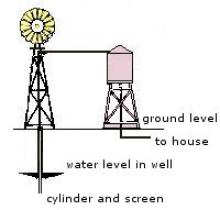Labour-saving technologies and practices: renewable energy resources
The following provides an outlook on the main renewable energy sources of biomass, solar, hydropower and wind. It highlights their advantages in terms of labour saving, livelihood resilience strengthening, livelihood diversification and cost. Disadvantages include technical issues, equipment, cost, skill, knowledge, risk, and infrastructure.
Description
1. Energy sources
1.1 Biomass energy
- The wood used in cooking stoves is renewable if used from sustainable sources such as woodlots.
- Crop residues and sawdust may be made into briquettes for burning in stoves.
- Animal waste is used dried and used as fuel.
- Animal waste is converted in digesters into methane gas, for use in gas stoves for cooking and lighting.
- The solid remainder is used as fertilizer.
1.2 Solar energy
- Solar energy is used directly for drying of crops, cooking with solar ovens and heating water.
- It is converted through photovoltaic panels into electricity for powering small water pumps, lights, refrigerators for medical use, telecommunications, small power tools, etc., and rechargeable batteries for continuity of supply.
- Costs of photovoltaic panels are decreasing as new manufacturing techniques are developed.
1.3 Hydropower energy
- Hydropower energy is usually used to generate electricity for use with community lighting, telecommunications, mechanical workshops or crop processing equipment.
- Depending on head and flow, high power outputs can be obtained.
- Hydropower energy is also used for directly driving machinery such as grain mills as well as for pumping water, such as ram pumps.
- It requires simple maintenance, has a long life before replacement parts needed and has very low running costs.
1.4 Wind energy
- Generally, wind energy is only suitable for use in regions where the average wind speed is over 3 m per second.
- It is widely used for water pumps to fill storage reservoirs for livestock in remote areas.
- Small windmills are also used for generating electricity for recharging batteries.
- Large wind turbines can be used for community power supplies.
2. Advantages
2.1 Labour saving
- It provides reliable power at very low power levels with minimal human intervention.
2.2 Livelihood resilience strengthening
- Gives off minimal or zero environmental pollution and quiet operation.
- The adoption of a renewable source diversifies the energy source pie for the household; making it less vulnerable to market shocks or environmental problems.
2.3 Livelihood diversification
- The power source may be used for income-generating activities such as workshops and crop processing.
2.4 Cost
- There are negligible running costs, with most renewable sources having no fuel or consumables requirements.
3. Disadvantages
3.1 Technical
- It is inflexible in terms of meeting variations in power demand (unless batteries or other means for storing power are used).
- There are relatively high costs in relation to their energy rating and power output.
3.2 Equipment
- Equipment is relatively complex to use.
3.3 Cost
- High capital costs are in relation to the power they give.
3.4 Skills and knowledge
- Generally unfamiliar technology and people unaware of different systems.
- Training is required in the efficient use of the equipment.
3.5 Risk
- Expensive and householders have limited financial capacity to pay for service.
3.6 Infrastructure
- Reasonably complex for the supply and maintenance of equipment.
Figure 1. Pumping scheme

©FAO/TECA
4. Related/associated technologies
- Improved domestic stoves to enhance energy efficiency and reduce consumption of wood & organic matter: ID 6844.
- Labour-saving technologies and practices: fuel-efficient stoves: ID 7297.
5. Objectives fulfilled by the project
5.1 Labour-saving technology (LST)
The technology allows for higher power reliability using very low power levels with limited human intervention.
5.2 Resource use efficiency
The technology is environmentally friendly, reduces pollution and diversifies energy usage.
5.3 Pro-poor technology
The technology has low running costs and the power source created can be used for income-generating activities
المؤلف: Rural Infrastructure and Agro-industries Division (Agricultural Machinery and Infrastructure) AGS in FAO
المنظمة: The Food and Agriculture Organization of the United Nations FAO TECA
السنة: 2020
التغطية الجغرافية: أفريقيا
النوع: الممارسات
النص الكامل متاح على: https://www.fao.org/teca/en/technologies/7300
لغة المحتوى: English
